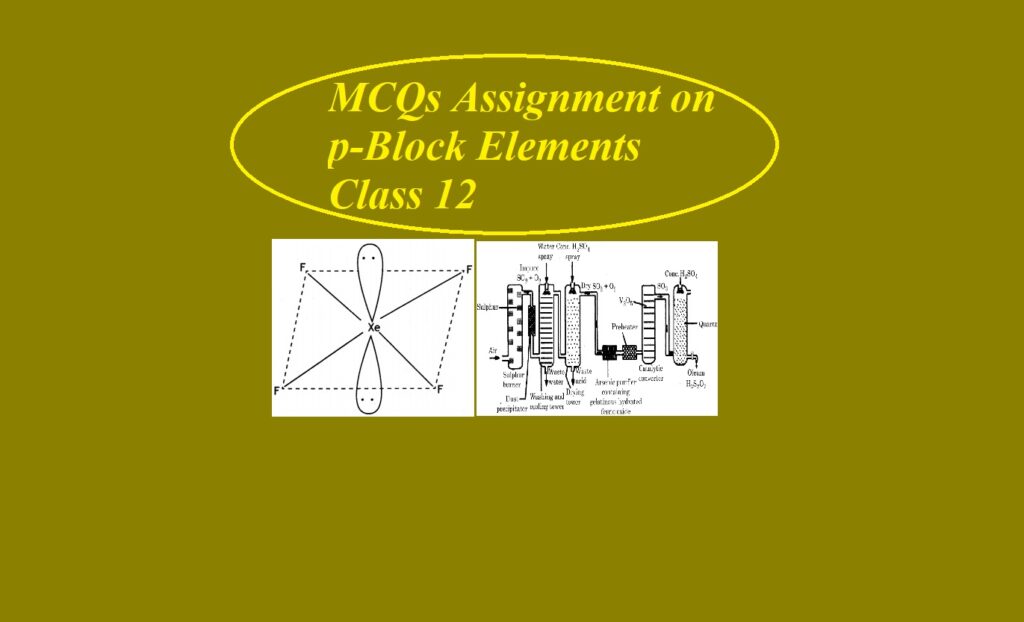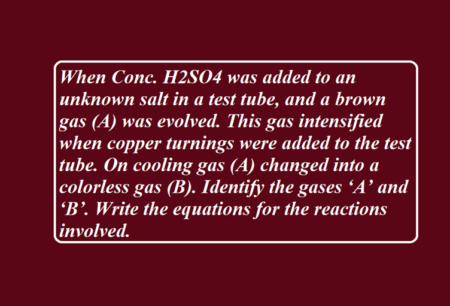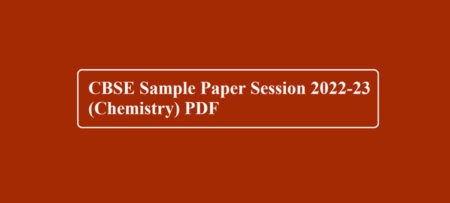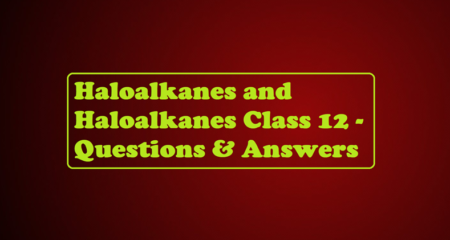MCQs Assignment on p-Block Elements Class 12
MCQs Assignment on p-Block Elements Class 12
Que 1. Arrange the following in order of increasing acidity H3PO4, H2CO3, HCl, HI
(a) H3PO4, HCl, H2CO3, HI (b) H3PO4, H2CO3, HCl, HI
(c) H2CO3, H3PO4, HCl, HI (d) None of these
Que 2. Which of the following oxides is the most acidic?
(a) N2O5 (b) P2O5 (c) As2O5 (d) Sb2O5
Que 3. On heating KClO3, we get
(a) KClO2 + O2 (b) KCl + O2
(c) KCl + O3 (d) KCl + O2 + O
Que 4. Which one is not a property of ozone?
(a) it acts as an oxidising agent in the dry state
(b) oxidation of KI into KIO2
(c) PbS is oxidised to PbSO4
(d) Hg is oxidised to Hg2O
Que 5. The number of P – O – P bonds in cyclic metaphosphoric acid is –
(a) zero (b) two (c) three (d) four
Que 6. Molecular shapes of SF4, CF4 and XeF4 are –
(a) The same with 2, 0 and 1 lone pairs of electrons respectively
(b) The same with 1, 1 and 1 lone pairs of electrons respectively
(c) Different with 0, 1 and 2 lone pairs of electrons respectively
(d) Different with 1, 0 and 2 lone pairs of electrons respectively.
Que 7. The correct order of acidic strength is –
(a) Cl2O7 > SO2 > P4O10
(b) CO2 > N2O5 > SO3
(c) Na2O > MgO > Al2O3
(d) K2O > CaO > MgO
Que 8. The correct order of increasing electron affinity of halogens is:
(a) 1 < Br < Cl
(b) Br < 1 < u
(c) Cl < Br < 1
(d) 1 < Cl < Br
Que 9. Which of the following is planar?
(a) XeO4 (b) XeO3F (c) XeO2F2 (d) XeF4
Que 10. Which one of the following molecules will form a linear polymeric structure due to hydrogen bonding?
(a) HCl (b) HF (c) H2O (d) NH3
MCQs Assignment on p-Block Elements Class 12
Que 11. The number of S–S bonds in sulphur trioxide trimer (S3O9) is –
(a) three (b) Two (c) one (d) zero
Que 12. Which of the following statements are correct?
(a) Among halogens, the radius ratio between iodine and fluorine is maximum
(b) Leaving F–F bond, all halogens have weaker X—X bond than X—X’ bond in interhalogens
(c) Among interhalogen compounds the maximum number of atoms are present in iodine fluoride.
(d) Interhalogen compounds are more reactive than halogen compounds
Que 13. The number of s – bonds in P4O10 is –
(a) 6 (b) 16 (c) 20 (d) 7
Que 14. In NO3– ion, the number of bonds pairs and lone pair of electrons of nitrogen atom are –
(a) 2, 2 (b) 3, 1 (c) 1, 3 (d) 4, 0
Que 15. Which of the following has pp-dp bonding?
(a) NO3– (b) SO32- (c) BO3–3 (d) CO3–2
Que 16. The number of lone pairs of electrons on Xe atoms in XeF2, XeF4 and XeF6 molecules are respectively –
(a) 3, 2 and 1 (b) 4, 3 and 2 (c) 2, 3 and 1 (d) 3, 2 and 0
Que 17. Which of the following statements are correct for SO2 gas?
(a) It acts as a bleaching agent in moist conditions
(b) Its molecule has linear geometry
(c) Its dilute solution is used as a disinfectant.
(d) It can be prepared by the reaction of dilute H2SO4 with metal sulphide.
Que 18. The true statement for the acids of phosphorus, H3PO2, H3PO3 and H3PO4 is –
(a) The order of their acidity is H3PO4 >H3 PO3> H3PO2
(b) All of them are reducing in nature
(c) All of them are tribasic acids
(d) The geometry of phosphorus is tetrahedral in all the three
Que 19. Which of the following substances has the highest proton affinity?
(a) PH3 (b) H2O (c) H2S (d) NH3
Que 20. On boiling phosphorus with KOH solution, the product formed is–
(a) Potassium sulphate (b) Phosphorus pentoxide
(c) Phosphorus hydroxide (d) Phosphine
MCQs Assignment on p-Block Elements Class 12
Que 21. Which of the following are isoelectric and isostructural? NO3–, CO32–, ClO3–, SO3
(a) NO3–, CO32– (b) SO3, NO3– (c) CO32–, ClO3– (d) CO32–, SO3
Que 22. Which of the following statements are true?
(a) The Only type of interactions between particles of noble gases are due to weak dispersion forces.
(b) Ionisation enthalpy of molecular oxygen is very close to that of Xenon.
(c) Hydrolysis of XeF6 is a redox reaction.
(d) Xenon fluorides are not reactive.
Que 23. [A] + H2SO4 → [B] a colourless gas with an irritating smell
[B] + K2Cr2O7 + H2SO4 → green solution. [A] and [B] are –
(a) SO32–, SO2 (b) Cl–, HCl (c) S2–, H2S (d) CO32–, CO2
Que 24. For H3PO3 and H3PO4, the correct choice is –
(a) H3PO3 is dibasic and reducing
(b) H3PO3 is dibasic and non-reducing
(c) H3PO4 is tribasic and reducing
(d) H3PO3 is tribasic and non-reducing
Que 25. The total number of lone pairs of electrons in XeOF4 is –
(a) 0 (b) 1 (c) 2 (d) 3
Que 26. The acid having O–O bond is –
(a) H2S2O3 (b) H2S2O6 (c) H2S2O8 (d) H2S4O6
Que 27. Among the following, the pair in which the two species are not isostructural is
(a) SiF4 and SF4 (b) IO3– and XeO3 (c) BH4– and NH4+ (d) PF6– and SF6
Que 28. In BrF3 molecule, the lone pairs occupy equatorial positions to minimise –
(a) lone pair-bond pair repulsion only
(b) bond pair-bond pair repulsions only
(c) lone pair-lone pair and lone pair-bond pair repulsions
(d) lone pair-lone pair repulsions only
Que 29. Which of the following is the increasing order of enthalpy of vaporization?
(a) NH3, PH3, AsH3 (b) AsH3 PH3, NH3
(c) NH3, AsH3, PH3 (d) PH3, AsH3, NH3
Que 30. Which of the following oxides of nitrogen is solid?
(a) NO2 (b) H2O (c) N2O3 (d) N2O5
MCQs Assignment on p-Block Elements Class 12
Que 31. Among Al2O3, SiO2, P2O3 and SO2, the correct order of acid strength is –
(a) SO2 < P2O3 < SiO2 < As2O3
(b) SiO2 < SO2 < As2O3 < P2O3
(c) As2O3 < SiO2 < SO2 < P2O3
(d) As2O3 < SiO2 < P2O3 < SO2
Que 32. Match the items of column 1 and column 2 and mark the correct option.
Column 1 Column 2
(A) Its partial hydrolysis does not (1) He change the oxidation state of the central atom
(B) It is used in modern diving apparatus (2) XeF6
(C) It is used to provide inert atmosphere (3) XeF4 for filling electrical bulbs
(D) Its central atom is in sp3d2 hybridisation (4) Ar
(a) A–1, B–4, C–2, D–3
(b) A–1, B–2, C–3, D–4
(c) A–2, B–1, C–4, D–3
(d) A–1, B–3, C–2, D–4
Que 33. Which among the following factors is most important in making fluorine the strongest oxidizing agent?
(a) electron affinity (b) ionization energy
(c) hydration energy (d) bond dissociation energy
Que 34. Which one of the following oxides is expected to exhibit paramagnetic behaviour?
(a) CO2 (b) ClO2 (c) SO2 (d) SiO2
Que 35. Which one of the following arrangements represents the correct order of electron gain enthalpy (with negative sign) of the given atomic species?
(a) F < Cl < O < S (b) S < O < Cl < F
(c) O < S < F < Cl (d) Cl < F < S < O
Que 36. The number of hydrogen atoms attached to phosphorus atom in hypophosphorus acid is –
(a) zero (b) two (c) one (d) three
Que 37. Which of the following isomers of phosphorus is thermodynamically most stable?
(a) Red (b) White (c) Black (d) Yellow
Que 38. Which of the following contains the maximum number of lone pairs of electrons on the central atom?
(a) ClO3– (b) XeF4 (c) SF4 (d) I3–
Que 39. Among the following molecules
(i) XeO3 (ii) XeOF4 (iii) XeF6
those having same number of lone pairs on Xe are –
(a) (i) and (ii) only (b) (i) and (iii) only
(c) (ii) and (iii) only (d) (i), (ii) and (iii)
Que 40. The number of P – O – P bonds in the structure of phosphorus pentoxide and phosphorus trioxide are respectively –
(a) 6, 6 (b) 5, 5 (c) 5, 6 (d) 6, 5
MCQs Assignment on p-Block Elements Class 12
Que 41. There are no S – S bond in –
(a) S2O42– (b) S2O52– (c) S2O32– (d) S2O72–
Que 42. In which of the following molecules/ ions are all the bonds not equal?
(a) SF4 (b) SiF4 (c) XeF4 (d) BF4–
Que 43. Which products are expected from the disproportionation reaction of hypochlorous acid?
(a) HClO3 and Cl2O (b) HClO2 and HClO4
(c) HCl and Cl2O (d) HCl and HClO3
Que 44. The decreasing values of bond angles for NH3 (106) to SbH3 (1010) down group 15 of the periodic table is due to –
(a) Increasing bond pair-bond pair repulsion
(b) Increasing p-orbital character in sp3
(c) Decreasing bond pair-bond pair repulsion
(d) Decreasing electronegativity
Que 45. Which of the following statements is true?
(a) H3PO3 is a stronger acid than H2SO3
(b) In an aqueous medium, HF is a stronger acid than HCl
(c) HClO4 is a weaker acid than HClO3
(d) HNO3 acid is a stronger acid than HNO2
Que 46. Which of the following chemical reactions depicts the oxidizing behaviour of H2SO4?
(a) 2 HI + H2SO4 → I2 + SO2 + 2 H2O
(b) Ca (OH)2 + H2SO4 → CaSO4 + 2 H2O
(c) NaCl + H2SO4 → NaHSO4 + HCl
(d) 2 PCl5 + H2SO4 → 2 POCl3 + 2 HCl
Assertion and Reason Type Note:
In the following questions, a statement of assertion followed by a statement of reason is given. Choose the correct answer out of the following choice.
(a) Both assertion and reason are correct statements, and the reason is the correct explanation of the assertion.
(b) Both assertion and reason are correct statements, but the reason is not the correct explanation of the assertion.
(c) Assertion is correct, but the reason is the wrong statement.
(d) Assertion is wrong but the reason is the correct statement.
(e) Both assertion and reason are wrong statements.
Que 47. Assertion: Hl cannot be prepared by the reaction of Kl with concentrated H2SO4.
Reason: Hl has the lowest H—X bond strength among halogen acids.
Que 48. Assertion: Both rhombic and monoclinic sulphur exist as S8 but oxygen exists as O2.
Reason: Oxygen forms pл – pл multiple bonds due to
Que 49. Which is the strongest acid?
(a) H2SO4 (b) HCl (c) HClO4 (d) HNO3
Que 50. Which of the following oxides of nitrogen is thermally most stable?
(a) N2O5 (b) N2O (c) NO (d) N2O3
MCQs Assignment on p-Block Elements Class 12
Que 51. Which inert gas has abnormal behaviour on liquefaction?
(a) Xe (b) He (c) Ar (d) Kr
Que 52. The bleaching action of CaOCl2 is due to –
(a) nascent oxygen (b) chlorine (c) HClO (d) HCl
Que 53. Nitrogen forms a variety of compounds in all oxidation states ranging from –
(a) – 3 to + 5 (b) – 3 to + 3 (c) – 3 to + 4 (d) – 3 to + 6
Que 54. High concentration of fluoride are poisonous and harmful to bones and teeth at levels over –
(a) 1 ppm (b) 3 ppm (c) 5 ppm (d) 10 ppm
Que 55. The compound which has molecular nature in gas phase but ionic in solid state is –
(a) PCl5 (b) CCl4 (c) PCl3 (d) POCl3
Que 56. Which of the following is the most basic oxide?
(a) SeO2 (b) Al2O3 (c) Sb2O3 (d) Bi2O3
Que 57. Which of the following orders is not in accordance with the property stated against it?
(a) F2 > Cl2 > Br2 > I2; bond dissociation energy
(b) F2> Cl2 > Br2 > I2; oxidizing power
(c) HI > HBr > HCl > HF; acidic property power
(d) F2 > Cl2 > Br2 > I2; electronegativity
Que 58. In which of the following molecules, are all the bonds not equal?
(a) NF3 (b) ClF3 (c) BF3 (d) AlF3
Que 59. In which of the following pairs, the two species are isostructural?
(a) BrO3– and XeO3 (b) SF4 and XeF4
(c) SO32– and NO3– (d) BF3 and NF3–
Que 60. Which of the following increasing order is not correct as mentioned in the property with it?
(a) HClO < HClO2 < HClO3 < HClO4 (thermal stability)
(b) HClO4 < HClO3 < HClO2 < HClO (oxidising power)
(c) F– < CI– < Br– < I– (reducing nature)
(d) HIO4 < ICI < l2 < HI (oxidation number of iodine)
MCQs Assignment on p-Block Elements Class 12
To Download the PDF Click



